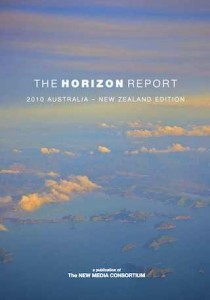It’s an engaging title, based on an appropriate metaphor: The Horizon Report. It’s positive, looks to the future, and seemingly offers hope and warm aspirations. The latest Australia-New Zealand Edition has recently been completed by the regional Advisory Board (a mammoth team of 32 – I didn’t recognise many names, to be honest, apart from Geoff Crisp!).
If you’re not already familiar with The Horizon concept, it’s a product of The New Media Consortium, an international (mostly US-based, not surprisingly) organisation ‘sparking innovation, learning and creativity’. Check the membership list – your institution may have joined (there’s a smattering of Australian universities, including UNSW, RMIT and USQ).
So, what does it offer us? Overall, the aim is to identify and describe ’emerging technologies likely to have a large impact over the coming five years … for their potential impact on and use in teaching, learning, and creative enquiry within higher education.’ With respect to the 5-year window, the specific timeframes addressed are ‘One year or less’, ‘Two to three years’ and ‘Four to five years’. Not surprisingly, nothing offered is particularly radical or confronting, but overall it’s a solid, comprehensive piece of work that respects its aim and reflects its methodology (including a modified Delphi technique). It’s logically and sensibly laid out, with sections on:
Key trends:
- ‘As the availability and use of electronic books continue to grow, the traditional publishing (and textbook) market is undergoing a profound and lasting change.
- Social and open forms of peer review and scholarship are gradually gaining acceptance.
- The availability of educational content for mobile devices is increasing as more providers develop for these platforms.
- Our notions of space and what constitutes learning environments continues to evolve.’
Critical challenges:
- ‘Even where technology for learning is strongly promoted, there remains a clear need for professional development opportunities around emerging technology.
- There is a conceptual mismatch between pedagogical practice and the design of many emerging technologies that makes it difficult for teachers to appreciate or use new tools.
- The need for formal instruction in key new skills, including information literacy, visual literacy, and technological literacy, poses a continuing challenge to educational programs.
- In today’s networked world, learners are placing greater value on knowing where to find information than on knowing the information themselves.’
Technologies to watch:
- Near horizon (within 12 months): electronic books and mobiles;
- Second adoption horizon (2 to 3 years): augmented reality and open content; and
- Far-term horizon (4 to 5 years): gesture-based computing and visual data analysis.
The report then delves in detail into each of the identified technologies. For example, the section on electronic books provides an overview, a discussion of relevance for teaching, learning and creative enquiry, and links to electronic books in practice, along with further reading. It also includes a link to the following engaging video on a possible future of the book.
The Future of the Book. from IDEO on Vimeo.
And while you’re at it, check the Project Wiki (where, for example, you’ll see the short-list of technologies which didn’t make the final list), as well as the overarching Horizon Project (for all you non-Aussies/Kiwis). There you’ll even find links to attractive Slideshare presentations that you may use in your own work (with appropriate attribution, of course).
PS Thanks to Helen Carter for alerting me to this publication.

Good to tell about the product of The New Media Consortium,the horizon report is good and useful,and the key about the Social and open forms of peer review,is really useful and good one,the things you tell about the Horizon Report,is really good and also useful to read,so good to allocate this information.